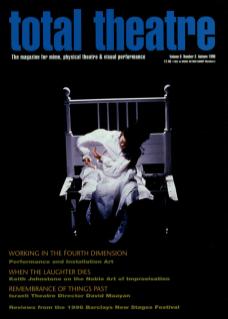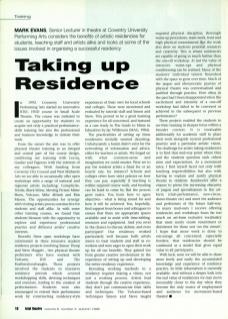In 1992 Coventry University Performing Arts started an innovative BTEC HND course in Small Scale Theatre. The course was initiated to create an opportunity for students to acquire not only a practical performance skills training but also the professional and business knowledge to initiate their work.
From the outset the aim was to offer physical theatre training as an integral and central part of the course design, combining my training with Lecoq, Gaulier and Pagneux with the interests of my colleagues. With funding from Coventry City Council and West Midlands Arts we are able to occasionally offer open workshops with a range of national and regional artists including: Complicite, Trestle, Black Mime, Moving Picture Mime Show, Volcano, Mike Alfreds and Bim Mason. The opportunities for synergy with visiting artists proves constructive for students and staff alike. As with some other training courses, we found that students blossom with the opportunity to explore and experience professional practice and different artists' creative interests.
Recently these open workshops have culminated in three intensive student residency projects involving Simon Thorp and Steve Hoggett, two physical theatre performers who have worked with Volcano, IOU and The Featherstonehaughs. These projects involved the students in intensive residency periods which covered workshopping skills, devising techniques and exercises, leading to the creation of performances. Students were also encouraged to extend their performance work by constructing residency-style experiences of their own for local schools and colleges. These were monitored and evaluated by tutorial staff and Simon and Steve. This proved to be a great learning experience for all concerned, and featured as a case study in The Guide to Mime in Education by Jac Wilkinson (MAG, 1984).
The practicalities of setting up these residencies initially seemed daunting. Unfortunately a forum didn't exist for the networking of information and advice, either for teachers or artists. We forged on with what common sense and imagination we could muster. Were we to pay the resident artists a fixed fee or an hourly rate, for instance? Schools and colleges often have strict policies on how they can pay, especially if teaching is within required course work, and funding can be hard to come by. But the process grew easier. You learn how to agree objectives – what is being aimed for and how it will be achieved. You, hopefully, find support from bosses and colleagues to ensure that there are appropriate spaces available and to assist with timetabling, resources and equipment. And you revel in the chance to discuss, debate, and even participate! Our residency worked particularly well because both artists strove to treat students and staff as coworkers and were eager to open their work up for all our benefits. They gained too from greater creative involvement in the experience of setting up and developing the entire residency experience.
Revealing working methods in a residency requires sharing a vision, not just a working process. Artists lead students through the creative experience, they don't just communicate their skills and techniques. The Volcano-based techniques Simon and Steve taught required physical discipline, thorough warm-up procedures, teamwork, trust and high physical commitment. But the work also drew on students’ personal resources and creativity. This is where residencies are capable of going so much further than the one-off workshop. At last the value of intensive warm-ups and physical conditioning can be realised. Many of the students' individual talents flourished with the space to grow over time. Much of the jargon and idiosyncratic practice of physical theatre was contextualised and justified through practice. How often in the past had I been disappointed when the excitement and intensity of a one-off workshop had failed to be conveyed or achieved in the subsequent or previous performance?
These projects enabled the students to see their training in sharper focus within a broader context. It is invaluable additionally for academic staff to place their work alongside current professional practice and a particular artistic vision. The challenge for artists taking residencies is to find that mid-way point where they and the students question each others aims and expectations. As a movement tutor, I find myself faced not only with teaching responsibilities but also with having to explain and justify physical theatre to students. Residencies offer a chance to pierce the increasing obscurity of jargon and specialisation in the artform (club-performance, new-circus, dance-theatre etc) and meet the audience and performers of the future half-way. So many mail-outs I receive offering residencies and workshops focus far too much on artform exclusive vocabulary that must surely create resentment or disinterest for those not 'on the circuit'. I hope that more work is done to encourage all concerned, especially funders, that residencies should be continued as a model that gives equal value to all participants.
With luck, soon we will be able to share more freely and easily the accumulated knowledge and experience of residency practice. So little information is currently available. And without a deeper look into the real value of residencies we may move inexorably closer to the day when they become the only source of employment and audience for movement-based theatre!

